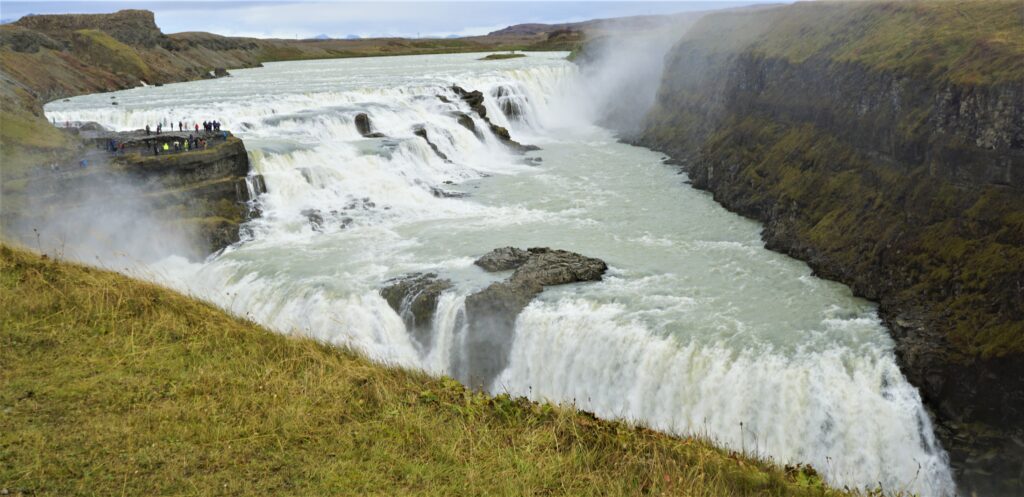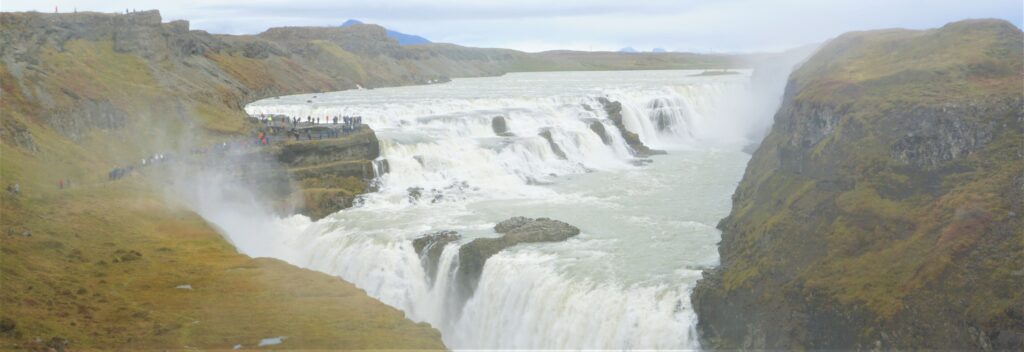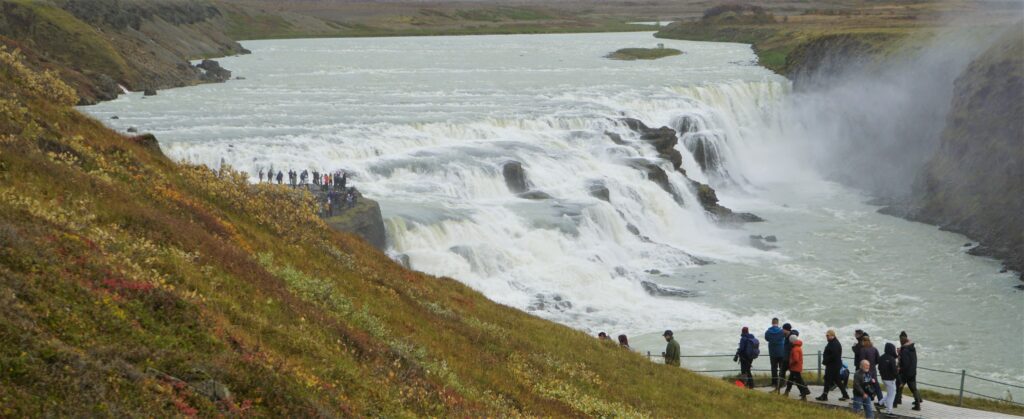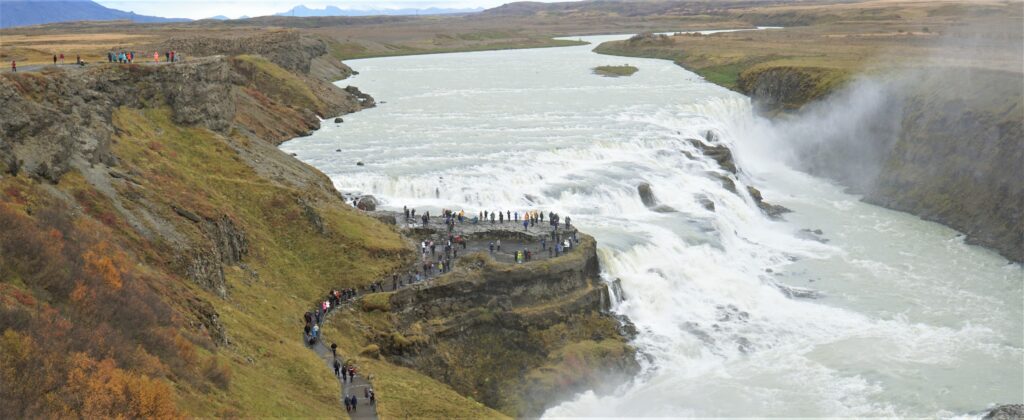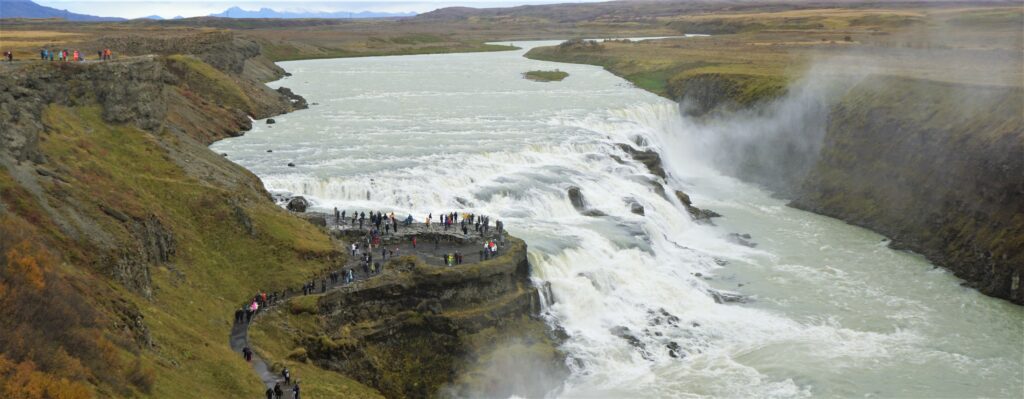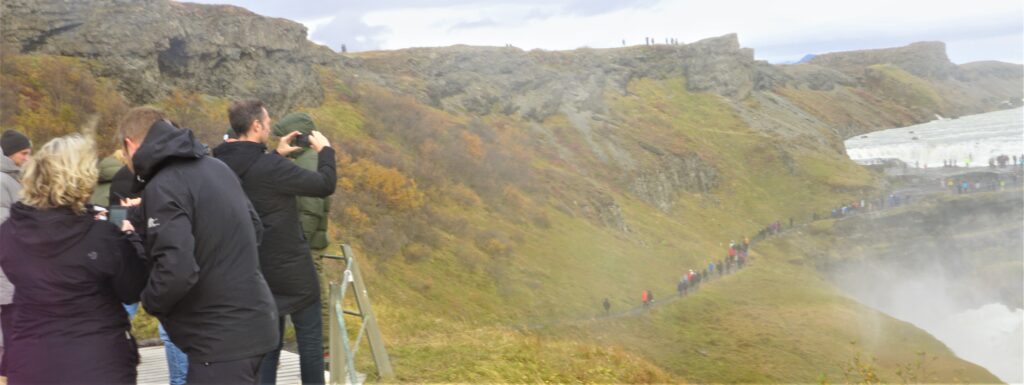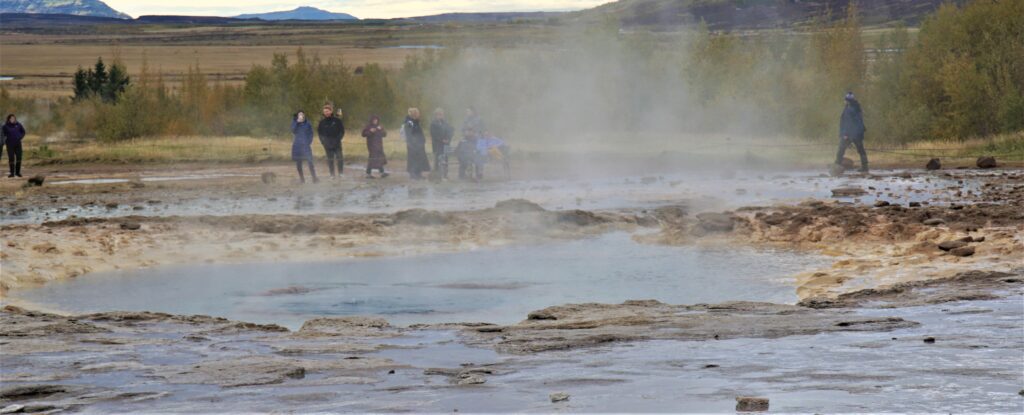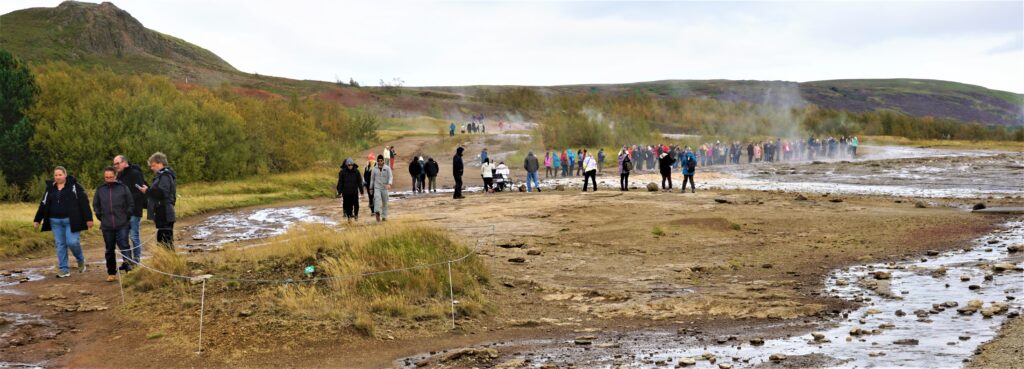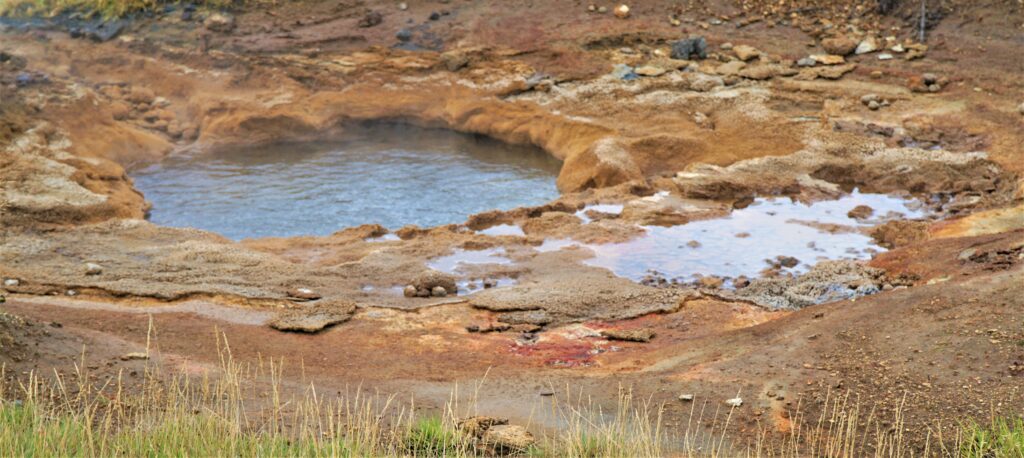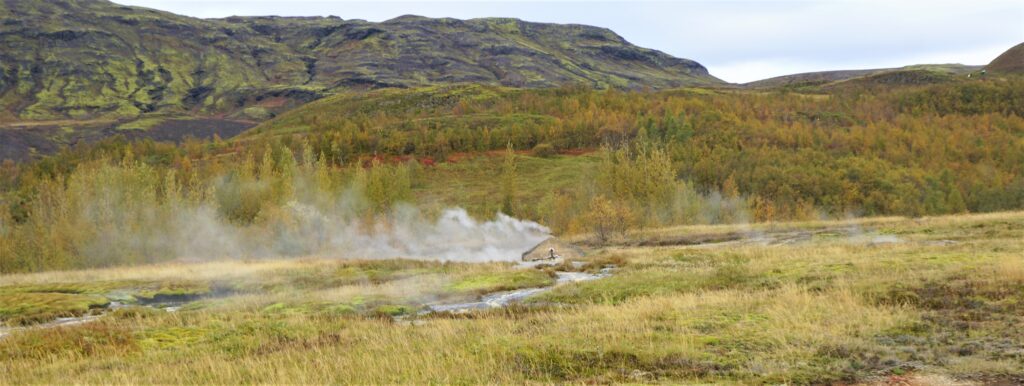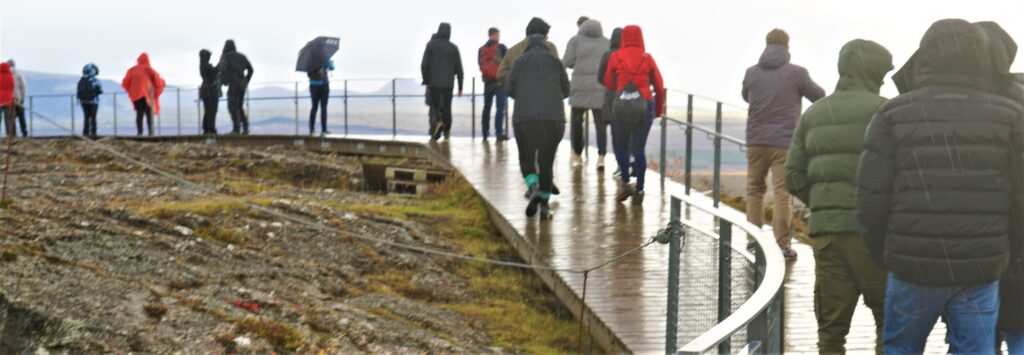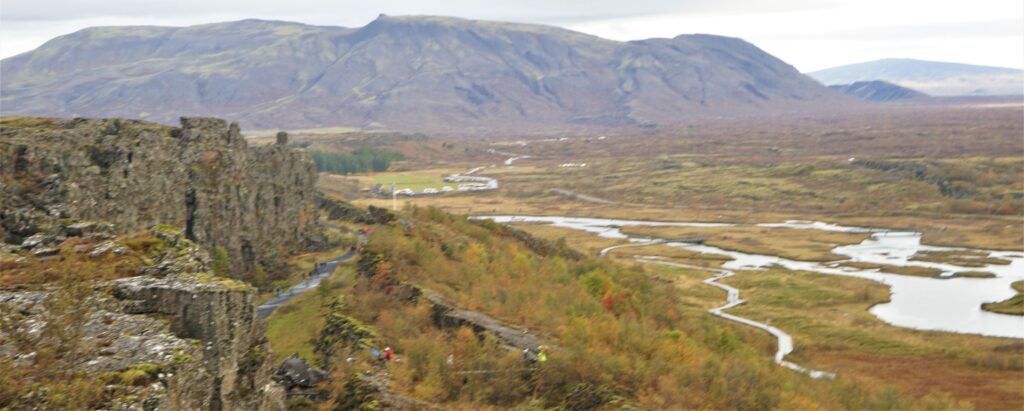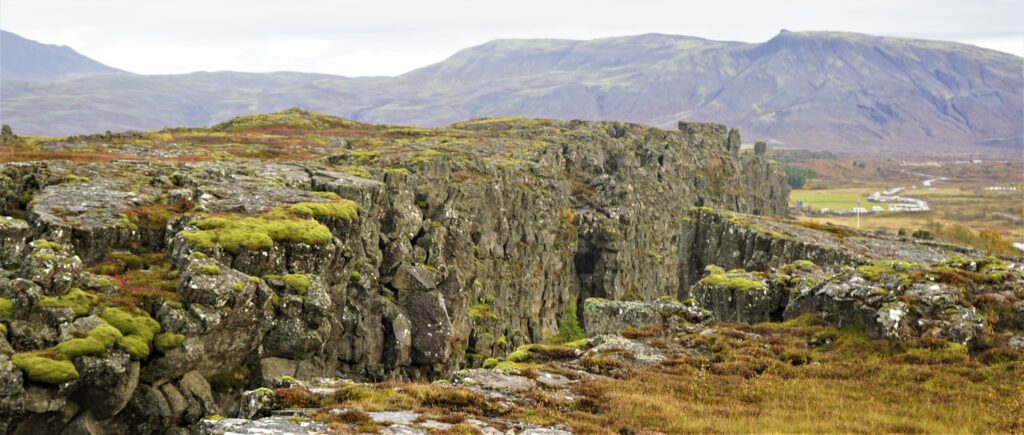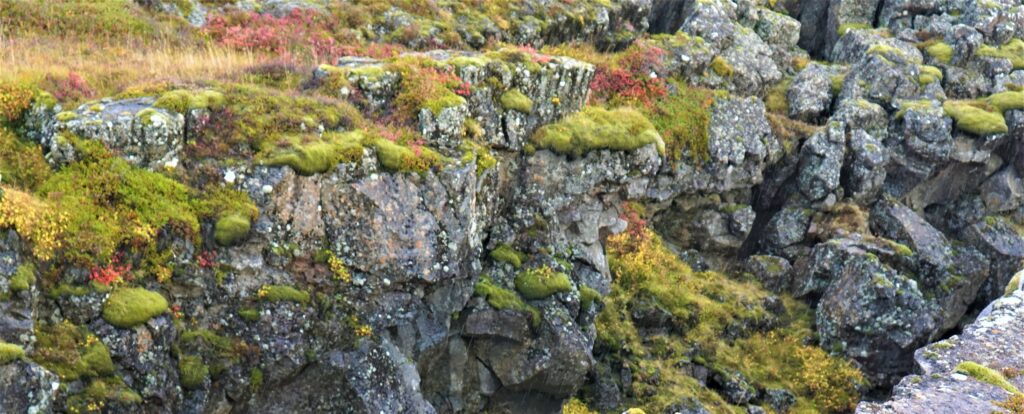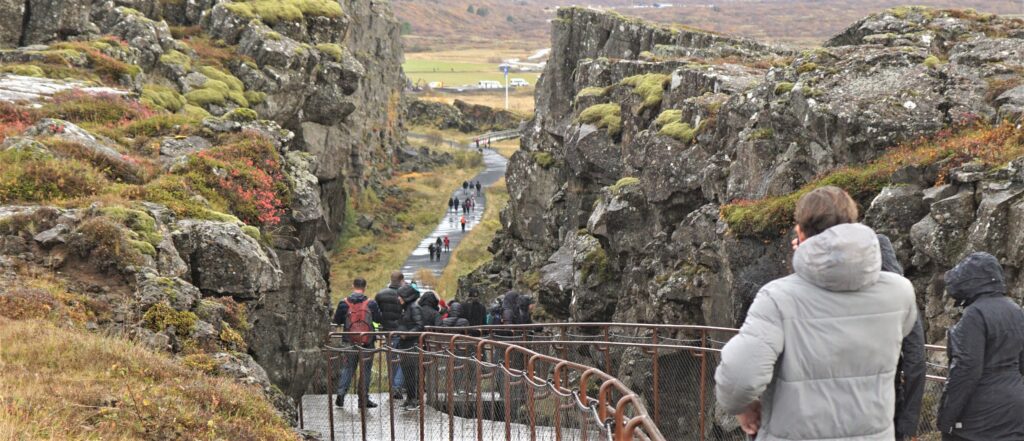Archive for September 30th, 2022
» posted on Friday, September 30th, 2022 by Linda Lou Burton
A Horse Of Course
Linda Lou Burton posting from Center Hotels Plaza, Reykjavik, Iceland – No, it’s not a 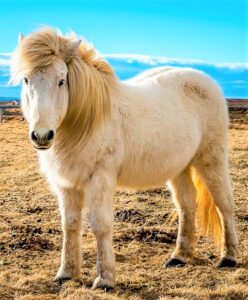 pony! Icelandic horses are small –52-56 inches tall, which is often considered “pony size” but make no mistake, this unique animal is a horse. It’s the only breed of horse in Iceland; Icelandic law does not allow horses to be imported into the country, and any horse that is exported can never return. Any equine equipment coming into the country must be new or fully disinfected. These horses are well-protected; a Horse Naming Commission even protects the naming of horses to retain Icelandic names and pronunciations. Owners of Icelandic horses and their breeders register their horses in WorldFeng, a world database of Icelandic horses. More than 400,000 horses, alive and dead, are registered in the database.
pony! Icelandic horses are small –52-56 inches tall, which is often considered “pony size” but make no mistake, this unique animal is a horse. It’s the only breed of horse in Iceland; Icelandic law does not allow horses to be imported into the country, and any horse that is exported can never return. Any equine equipment coming into the country must be new or fully disinfected. These horses are well-protected; a Horse Naming Commission even protects the naming of horses to retain Icelandic names and pronunciations. Owners of Icelandic horses and their breeders register their horses in WorldFeng, a world database of Icelandic horses. More than 400,000 horses, alive and dead, are registered in the database.
What’s so special about the Icelandic horse? Let me begin a list: they are friendly and not easily spooked. They are hardy and easy to keep. They have a no-nonsense look – well-proportioned heads, short muscular necks, a long back, and strong, short legs. Their double coat gives them extra insulation for Iceland’s cold temperatures, and those coats come in many colors; there are over a hundred names in the Icelandic language for the various color patterns. Rick passed a few horses in the fields on the Golden Circle Tour today but they didn’t stop there; many tours include horseback riding however.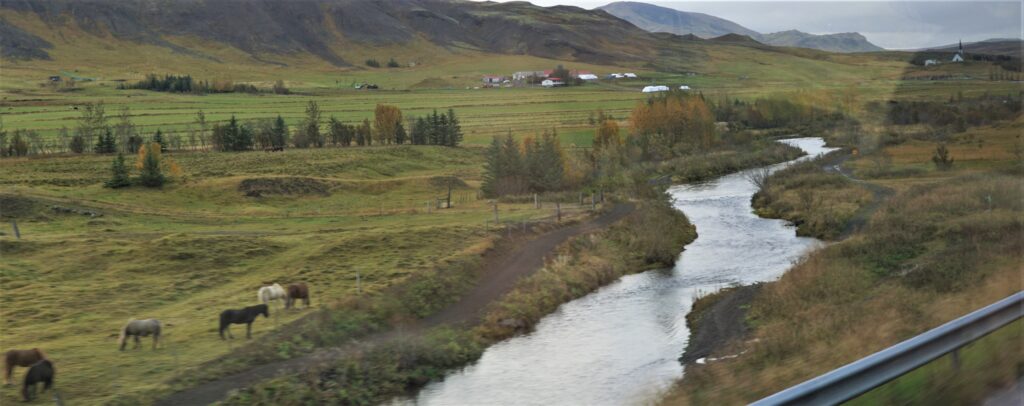
 Though the first horses were brought to Iceland by Norse settlers in the 900s, the horses you see today are a result of selective breeding over the centuries. Highly fertile and long-lived, they are “bred to the task” -some solely for horsemeat; some for pack and draft work; some for work under saddle. The Icelandic is a “five-gaited” breed – the walk, trot, and gallop that most horses do, plus the tolt and the flying pace. The tolt is a natural gait present from birth;
Though the first horses were brought to Iceland by Norse settlers in the 900s, the horses you see today are a result of selective breeding over the centuries. Highly fertile and long-lived, they are “bred to the task” -some solely for horsemeat; some for pack and draft work; some for work under saddle. The Icelandic is a “five-gaited” breed – the walk, trot, and gallop that most horses do, plus the tolt and the flying pace. The tolt is a natural gait present from birth;  it offers a smooth fast ride with no bounce; imagine the comfort in that! The flying pace is used for racing; horses that can perform both gaits are considered the best of the breed. The first breed society for the Icelandic horse was created in Iceland in 1904; today the breed is represented by organizations in 19 different nations, organized under the International Federation of Icelandic Horse Associations.
it offers a smooth fast ride with no bounce; imagine the comfort in that! The flying pace is used for racing; horses that can perform both gaits are considered the best of the breed. The first breed society for the Icelandic horse was created in Iceland in 1904; today the breed is represented by organizations in 19 different nations, organized under the International Federation of Icelandic Horse Associations.
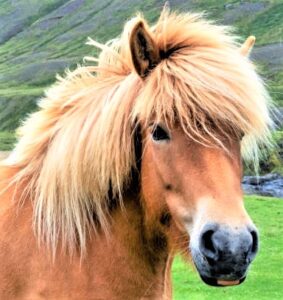 “Would you go horseback riding here if we had another day?” I asked Rick on the way back to our hotel. “Maybe,” he said. “The tolt sure sounds like a smoother ride than a 4×4.” Now there’s a thought! Tradition says you should never ride a horse whose name you don’t know, or understand. “You’d have to check out the horse’s name with the guide,” I told him. “Pick one named Farfús, it means likes to travel.”
“Would you go horseback riding here if we had another day?” I asked Rick on the way back to our hotel. “Maybe,” he said. “The tolt sure sounds like a smoother ride than a 4×4.” Now there’s a thought! Tradition says you should never ride a horse whose name you don’t know, or understand. “You’d have to check out the horse’s name with the guide,” I told him. “Pick one named Farfús, it means likes to travel.”
Our Farfús days are near the end. Tomorrow we go home. “Let’s pack,” was our goodnight. I’ve got more to tell you about Icelandic names, however. Next post?
WorldFeng Studbook of Origin https://www.worldfengur.com/
Center Hotels Plaza, Reykjavik, Iceland https://www.centerhotels.com/en/hotel-plaza-reykjavik
Next Post: Sons and Dottirs
» posted on Friday, September 30th, 2022 by Linda Lou Burton
The Golden Circle – Gullfoss
Linda Lou Burton posting from Center Hotels Plaza, Reykjavik, Iceland – I like a good story. 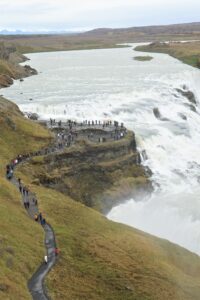 And this one is pretty good, in fact, it’s legendary. While Rick was riding the bus around the southwestern part of Iceland on the Golden Circle Tour, getting wet in the rain, and geyser spray, and waterfall mist, I spent some time (between naps) reading about what he was seeing. “Did the Tour Guide tell you about Tomas Tomasson and his daughter Sigridur Tomasdottir?” I asked him when he got back to the hotel. He shook his head. “No, but I want to tell you about the Icelandic horses we saw.” Since we had stories to swap, we decided to head for what was now our favorite restaurant (just across the street), and talk while enjoying the lamb dinner we’d promised ourselves. Saeta Svinid (Sweet Pig) was buzzing, a good Friday night crowd, and we got our orders in quickly: lamb shoulder slow cooked for 12 hours, perfect for two to share, and oven-baked lobster tails with sweetcorn-chili salsa. I told my story first.
And this one is pretty good, in fact, it’s legendary. While Rick was riding the bus around the southwestern part of Iceland on the Golden Circle Tour, getting wet in the rain, and geyser spray, and waterfall mist, I spent some time (between naps) reading about what he was seeing. “Did the Tour Guide tell you about Tomas Tomasson and his daughter Sigridur Tomasdottir?” I asked him when he got back to the hotel. He shook his head. “No, but I want to tell you about the Icelandic horses we saw.” Since we had stories to swap, we decided to head for what was now our favorite restaurant (just across the street), and talk while enjoying the lamb dinner we’d promised ourselves. Saeta Svinid (Sweet Pig) was buzzing, a good Friday night crowd, and we got our orders in quickly: lamb shoulder slow cooked for 12 hours, perfect for two to share, and oven-baked lobster tails with sweetcorn-chili salsa. I told my story first.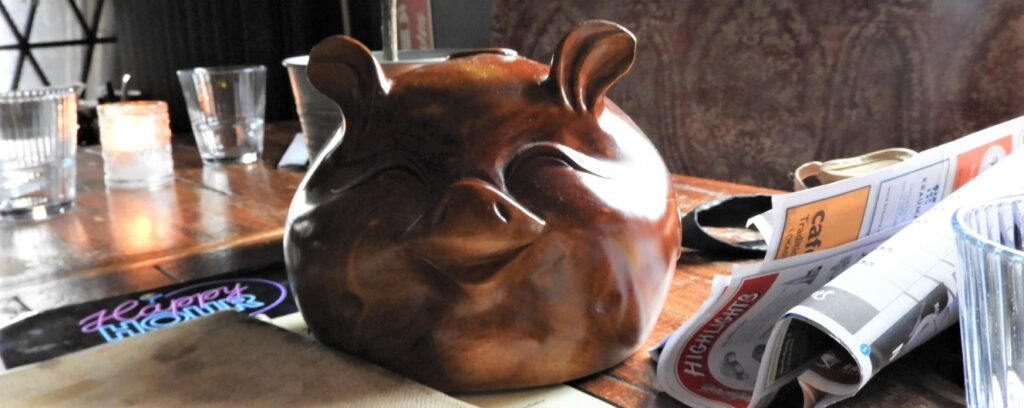
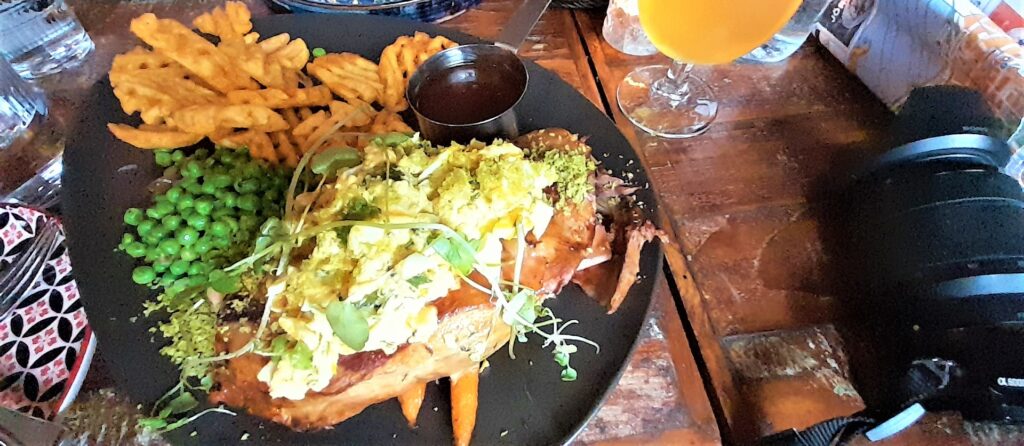
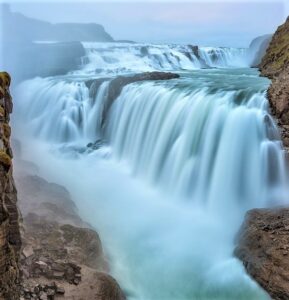 Gullfoss, translated Golden Falls, Rick’s third major stop today, isn’t Iceland’s biggest waterfall, but it is a showstopper, a roaring spectacle that angles water left and then right as it plunges down a curved three-step staircase into Gullfossgifur canyon. It’s the Hvita River, coming from the Langiokull glacier; walkways down and around let you get close enough for a good drenching by Mother Nature’s power. In 1907 that power caught the attention of an English businessman by the name of Howell who wanted to build a hydroelectric plant there. At the time, a farmer named Tomas Tomasson owned Gullfoss and staunchly refused to sell; though eventually he leased some of the land to Howell, not realizing the contract had a loophole favoring Howell — oops. Sigridur Tomasdottir, who grew up on her
Gullfoss, translated Golden Falls, Rick’s third major stop today, isn’t Iceland’s biggest waterfall, but it is a showstopper, a roaring spectacle that angles water left and then right as it plunges down a curved three-step staircase into Gullfossgifur canyon. It’s the Hvita River, coming from the Langiokull glacier; walkways down and around let you get close enough for a good drenching by Mother Nature’s power. In 1907 that power caught the attention of an English businessman by the name of Howell who wanted to build a hydroelectric plant there. At the time, a farmer named Tomas Tomasson owned Gullfoss and staunchly refused to sell; though eventually he leased some of the land to Howell, not realizing the contract had a loophole favoring Howell — oops. Sigridur Tomasdottir, who grew up on her  father’s sheep farm, was determined to preserve the land; she hired a lawyer and the fight began. The case continued for many years; as the story goes, Sigridur walked to Reykjavik (62 miles) many times, even threatening to throw herself into the waterfall if any construction began. She eventually succeeded! In 1929 Howell withdrew from the lease and the waterfall came back into the hands of the Icelandic people. Sigridur is hailed as “Iceland’s first environmentalist” and her contribution is marked in stone – a plaque bearing her image sits at the top of Gullfoss. And the lawyer who helped Sigridur? He became the first president of an independent Iceland in 1944! Good story, I say. Good job Sigridur!
father’s sheep farm, was determined to preserve the land; she hired a lawyer and the fight began. The case continued for many years; as the story goes, Sigridur walked to Reykjavik (62 miles) many times, even threatening to throw herself into the waterfall if any construction began. She eventually succeeded! In 1929 Howell withdrew from the lease and the waterfall came back into the hands of the Icelandic people. Sigridur is hailed as “Iceland’s first environmentalist” and her contribution is marked in stone – a plaque bearing her image sits at the top of Gullfoss. And the lawyer who helped Sigridur? He became the first president of an independent Iceland in 1944! Good story, I say. Good job Sigridur!
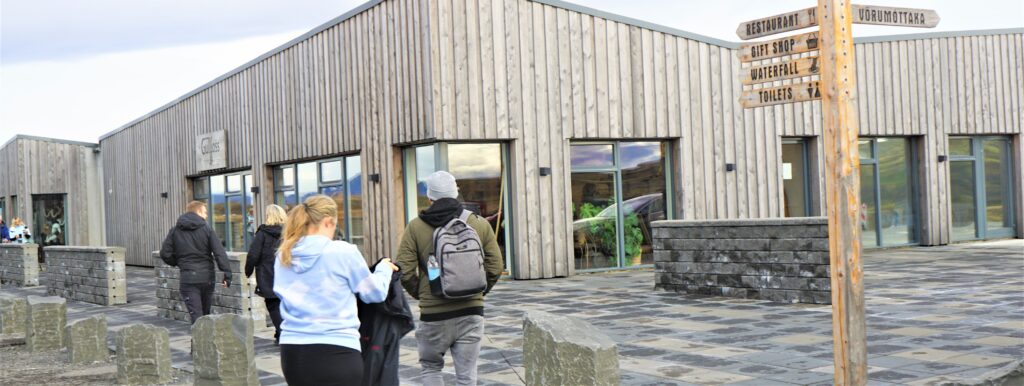 “Did you eat lunch at the Gullfoss Restaurant today? It overlooks the falls, doesn’t it?” I asked Rick. “No, I skipped lunch,” he answered. “The restaurant looked nice but the line was long and we only had a 45-minute stop. I chose to spend my time looking at the falls.” No wonder our slow-cooked lamb dinner was disappearing so fast! We were both starving and it was primo delicious. Rick’s photos below, his story of the Icelandic horses in the next post.
“Did you eat lunch at the Gullfoss Restaurant today? It overlooks the falls, doesn’t it?” I asked Rick. “No, I skipped lunch,” he answered. “The restaurant looked nice but the line was long and we only had a 45-minute stop. I chose to spend my time looking at the falls.” No wonder our slow-cooked lamb dinner was disappearing so fast! We were both starving and it was primo delicious. Rick’s photos below, his story of the Icelandic horses in the next post.
Golden Circle Tours https://www.re.is/golden-circle-tours/
Center Hotels Plaza, Reykjavik, Iceland https://www.centerhotels.com/en/hotel-plaza-reykjavik
Next Post: A Horse Of Course
» posted on Friday, September 30th, 2022 by Linda Lou Burton
The Golden Circle – Geysir
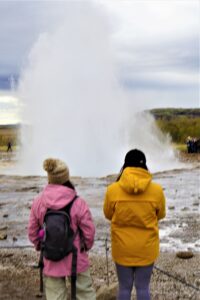 Linda Lou Burton posting from Center Hotels Plaza, Reykjavik, Iceland – It’s all in a name, they say. Start with the Icelandic verb geysa meaning “to gush.” Then give the name Geysir to some water gushing out of the ground periodically in a particular place in Iceland’s Haukadalur Valley. Somehow or other, over time, “geysir” became the anglicized word “geyser” that we use for all periodically spouting, gushing, hot springs, like Yellowstone’s Old Faithful. Iceland’s geyser Geysir is less faithful than Old Faithful these days, (so is Old Faithful, for that matter), mainly due to volcanic activity and shifts in the water table. In 1910 Geysir was active every 30 minutes; by 1916 the eruptions almost ceased. In the 1980s it was tinkered with and eruptions forced; that was a tacky move however and was stopped. Mother Nature sent an earthquake in 2000 that revived Geysir, it spewed for for two days to a height of 400 feet! Not happening now, however, and not what Rick saw today on the Golden Circle Tour. He did see a neighboring geyser however, Little Geysir, aka Strokkur.
Linda Lou Burton posting from Center Hotels Plaza, Reykjavik, Iceland – It’s all in a name, they say. Start with the Icelandic verb geysa meaning “to gush.” Then give the name Geysir to some water gushing out of the ground periodically in a particular place in Iceland’s Haukadalur Valley. Somehow or other, over time, “geysir” became the anglicized word “geyser” that we use for all periodically spouting, gushing, hot springs, like Yellowstone’s Old Faithful. Iceland’s geyser Geysir is less faithful than Old Faithful these days, (so is Old Faithful, for that matter), mainly due to volcanic activity and shifts in the water table. In 1910 Geysir was active every 30 minutes; by 1916 the eruptions almost ceased. In the 1980s it was tinkered with and eruptions forced; that was a tacky move however and was stopped. Mother Nature sent an earthquake in 2000 that revived Geysir, it spewed for for two days to a height of 400 feet! Not happening now, however, and not what Rick saw today on the Golden Circle Tour. He did see a neighboring geyser however, Little Geysir, aka Strokkur.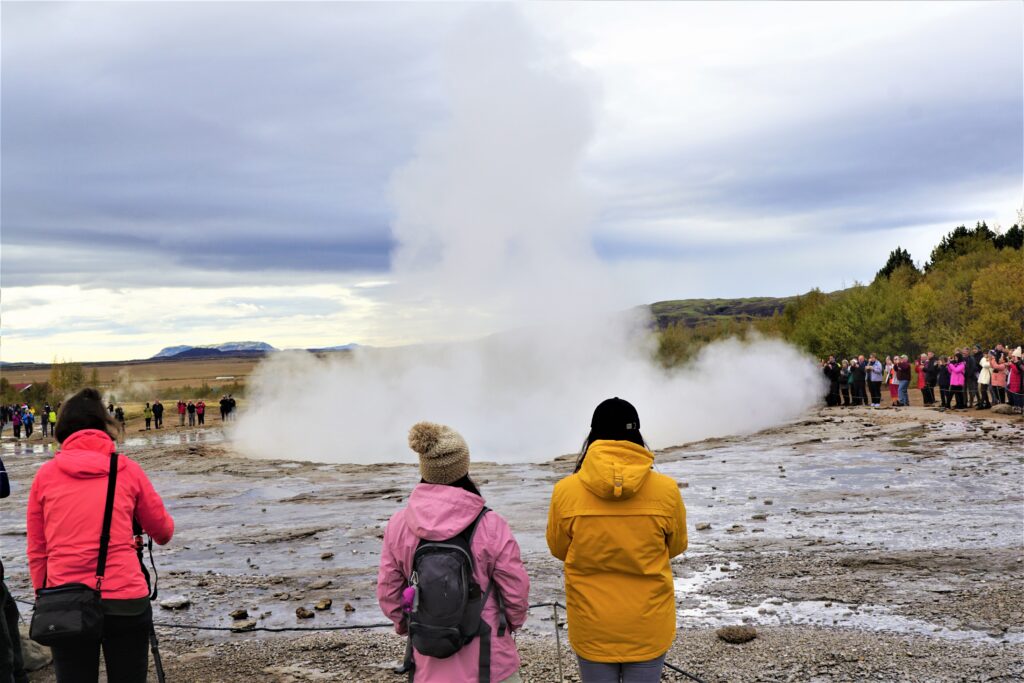
It erupts every few minutes, spewing up almost a hundred feet; if you miss it, just wait, camera ready, for the next eruption. There are 30 or so smaller geysers and hot pools in the area, note the crowd circled on a chilly day around this geothermal warmth. Just another of Iceland’s many wonders! It was a great stop on the Tour, with Geysir Center, Restaurant, and Hotel nearby, handy for picking up souvenirs, eating and coming back to for a longer stay. “With warmer clothes,” Rick commented. His photos below.
Curious about Old Faithful’s spewing height? It averages about 150 feet. Record holder in the world? Maimangu Geyser near Rotorua, New Zealand once shot up 1,500 feet!
Golden Circle Tours https://www.re.is/golden-circle-tours/
Geysir Hotel and Restaurant and Center https://hotelgeysir.is/geysir-restaurant/
Center Hotels Plaza, Reykjavik, Iceland https://www.centerhotels.com/en/hotel-plaza-reykjavik
Next Post: The Golden Circle – Gullfoss
» posted on Friday, September 30th, 2022 by Linda Lou Burton
The Golden Circle – Thingvellir
Linda Lou Burton posting from Center Hotels Plaza, Reykjavik, Iceland – Geysir, Gullfoss and Thingvellir. Are you up on your Icelandic? These are the names of sights you see on the Golden Circle bus tour. “Golden Circle” is the marketing term for a loop drive of 190 miles departing Reykjavik and circling back; it takes about six hours so is very popular for folks (like us) who only have a short time to stay. And it provides great exposure to the countryside with stops at three of Iceland’s most unique areas – Geysir, Gullfoss and Thingvellir. There was an exhibit about Thingvellir in Perlan we saw yesterday, where its significance began to sink in.
Chieftains from across Iceland gather in Thingvellir to form Althing – the oldest parliament in the world. The rock formations at Thingvellir form a natural amphitheater.
The year was 930! From 930 AD until 1798, Thingvellir was the assembly site for the national parliament of Iceland, the Althing, from which Thingvellir (Assembly Plains) derives its name. The assembly was a forum to recite laws and make amendments, resolve conflicts and feuds, and make trade and marriage arrangements. The acoustics of the canyon walls helped speakers voices carry further. This spot is so important to Iceland’s history it is a protected national shrine. Legislation passed in 1928 created Thingvellir National Park.
The Park has been declared a UNESCO WORLD HERITAGE SITE not only for its historical significance but its geological uniqueness as well. The area lies directly on the mid-Atlantic ridge, where those North American and Eurasian tectonic plates are slowly separating. Many enormous rifts and canyons are above water, but some of the fissures, such as Silfra, are now submerged. You can make arrangements (if you have proper diving credentials) to swim between these plates in the clearest water on earth — touch North America, then Europe! 
We weren’t planning on that, though I have family members that I’d like to encourage to “swim at Silfra.” Justin? Hal? Come with me when I make a trip back to Iceland. I have to come back because, rats again, I wasn’t able to go on the tour with Rick today. Twenty-one non-stop travel days took their toll, so the photos below are courtesy of Rick, who bundled up in his brown fleece and braved the wind to add yet another world-famous national park to his repertoire. Thanks Rick! See the cliffs of Thingvellir, and note that tiny church in the valley.
The first church was built here in 1015 following a gift of timber and a bell from King Olaf of Norway. The current church was built in 1859 and serves a small congregation today. The three bells in the tower are historic: one from that first church, one dating from 1697, and one added June 17, 1944, when the Icelandic republic was established at Thingvellir. The house beside the church serves as the summerhouse for the Prime Minister of Iceland.
Golden Circle Tours https://www.re.is/golden-circle-tours/
Thingvellir National Park https://www.thingvellir.is/en/things-to-do/
Diving at Silfra https://www.dive.is/dive-sites/silfra
Center Hotels Plaza, Reykjavik, Iceland https://www.centerhotels.com/en/hotel-plaza-reykjavik
Next Post: The Golden Circle – Geysir

